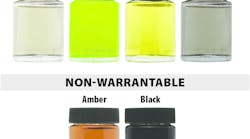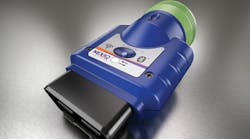The A/C tune-up is a rite of spring and the centerpiece is a system flush. For medium duty trucks, the A/C system should be flushed every 12 months in typical highway service or 750 operating hours for trucks in on/off-highway vocational applications, recommends Gary Hansen, vice president of Red Dot (www.rdac.com), a company that designs OE and aftermarket HVAC systems for commercial vehicles and off-highway equipment.
But a flush may not seem to make sense when the A/C still blows cool air.
Refrigerant or PAG (synthetic compressor) oil is clear, he explains. Over time, it picks up moisture and turns acidic, eating away at the condenser, thermal expansion valve, evaporator, fittings, compressor and other metal components.
Gradually, the oil turns yellow and darkens as it picks up particles and sludge. Dirty oil can clog expansion valves and orifice tubes, depriving the compressor of the lubrication it needs to reduce friction and heat.
“When we see a failed compressor, orange or brown oil indicates a maintenance issue, not a defect in materials or workmanship,” says Hansen. “When a compressor fails due to a defect, it fails shortly after installation. The oil tends to be grey. It hasn’t been in service long enough to turn acidic and amber.”
Flushing the A/C system not only can improve uptime and reduce maintenance costs for the fleet, it can generate additional parts sales for the shop. A flush is an opportunity to sell receiver-driers, O-ring kits, expansion valves, hoses and other components.
QUALITY REFRIGERANT
A flush does little good unless you put quality refrigerant back into the system Red Dot’s Hansen points out.
“When you buy a new tank of R-134a, test it,” he advises. “It may look okay, right down to the fittings and labels, but we’re seeing more and more counterfeit refrigerant being sold. The packaging and labeling appear genuine but the refrigerant itself may contain hydrochlorofluorocarbons (HFC), chlorofluorocarbons (CFC) and other harmful chemicals.”
Other hydrocarbon blends make no bones about being cheap substitutes for R-134a, he adds. Because these refrigerants may contain high quantities of propane, isobutane and other flammable gases, the U.S. EPA has banned them as an HFC replacement and many states have made them illegal. Among the hazards:
- Hydrocarbon blends are highly flammable and in a confined space may burn or explode in the presence of an open flame, spark or cigarette.
- No manufacturer has endorsed or authorized the use of hydrocarbon refrigerants in current-production A/C systems. “Use them and you risk voiding your warranty,” warns Hansen.
- Blends can degrade gaskets and hoses, making leaks more likely.
“When you’re starting work on a system, never presume that it has straight R-134a,” he says. “Check for leaks before making an inspection or repair that requires an ignition source or may generate one, and use properly calibrated tools to identify and sniff out the chemicals in the system.”
CHECK SERVICE EQUIPMENT
After the initial investment, A/C service equipment requires little to operate in terms of materials or a technician’s time. All that needs to be done is to keep the machines running.
The first line of defense is the use of a quality refrigerant identifier, says Hansen. In recovery equipment, stop-leak chemicals in cans of R-134a can gum up the inner workings and attack rubber seats and plungers. If contaminated refrigerant enters the storage cylinder, “trace amounts can be passed along like a virus to virtually every other vehicle you service.”
The next step is to commit to a preventive maintenance (PM) routine. A recovery station has a compressor, hoses and filters that need regular attention, he says. Most equipment today has built-in maintenance reminders, but shop managers need to make sure everyone knows who’s responsible for checking oil, changing filters, calibrating scales and so on.
Finally, Hansen concludes, “the best way to protect your equipment is not to let in contaminated refrigerant in the first place. With summer almost here, talk to your technicians about the procedures they use to protect A/C systems, service equipment and technicians from the hazards of poor-quality refrigerants.”





